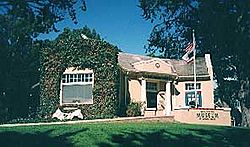Santa Cruz Museum of Natural History facts for kids

The outside of the museum building.
|
|
| Established | 1905 |
|---|---|
| Location | Santa Cruz, California |
| Type | Natural History |
| Visitors | 30,000 annually |
The Santa Cruz Museum of Natural History is one of the oldest museums in California. Locals often call it "the Whale Museum" because of the life-size whale model outside! It started in 1905 with a collection from a nature lover named Laura Hecox.
Over the years, the museum gathered many more items. These include Native American tools and art, ancient objects, and things from nature like animal specimens. Today, the museum is located in a historic building that was once a Carnegie Library, built in 1915.
Contents
The Museum's Story
A Lighthouse Keeper's Collection
The museum's story begins with Laura Hecox, who was born in Santa Cruz in 1854. From a young age, she loved studying nature. Her father became the keeper of the Santa Cruz Lighthouse, and the family lived there.
Laura started collecting seashells, rocks, fossils, and Native American artifacts. She turned part of the lighthouse into her own small museum. When her father passed away in 1883, Laura took over as the official lighthouse keeper. She held the job for 33 years! On weekends, she would give tours of the lighthouse and show visitors her amazing collection.
Becoming a Public Museum
In 1904, Laura Hecox gave her entire collection to the city of Santa Cruz. She wanted everyone to enjoy it. The city used her collection to start its first public museum. It opened on August 21, 1905, in the basement of the new Carnegie Library.
The first exhibits showed off dried sea stars, Native American baskets, colorful minerals, bird nests, and hundreds of seashells. Laura said she wasn't losing her collection, but sharing it with everyone.
Later, in 1929, a man named Humphrey Pilkington gave his large collection of Native American artifacts to the city. He was the first warden at what is now Big Basin Redwoods State Park. His gift helped the museum grow even more.
A New Home in Seabright
The museum moved a few times. In 1930, it settled in a building in the Seabright neighborhood of Santa Cruz. The Hecox and Pilkington collections were finally together in one place. For a while, the museum even ran a public aquarium on the Santa Cruz Wharf.
In 1954, the museum moved next door into the building where it is today. This building was also a Carnegie Library, built in 1915. Over the next few decades, volunteers and staff added new rooms and exhibits. They also started programs to teach local students about nature.
The Museum Today
The museum has continued to grow and change with the help of different leaders and the community.
In the 1970s, the museum started popular yearly events like the Fungus Fair. In 1982, the famous life-size gray whale model was built outside the museum. It was paid for by donations from people in the community.
In 2009, the Santa Cruz Museum Association, a non-profit group, took over running the museum to keep it open for everyone. Today, the museum is led by Executive Director Felicia Van Stolk. She and her team work to create fun exhibits and programs that teach visitors about the natural world and how we can protect it.
The Surfing Museum
In 1986, the Museum of Natural History opened a second, smaller museum. The Santa Cruz Surfing Museum is located in a lighthouse at a popular surf spot. It shows the history of surfing in Santa Cruz with old surfboards and photos. It is a very popular attraction for tourists and locals.

